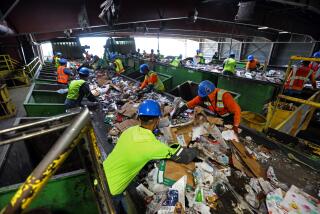Products Are Designed to Pull Apart--for Recycling
- Share via
ROCHESTER, N.Y. — Industrial designers and engineers spend most of their time figuring out the best way to put products together.
Now, some of them are examining how to take those products apart.
Driven by environmental concerns, soaring landfill costs and the need to save money on materials, manufacturers are starting to think about what happens to products at the end of their life cycle.
“Products in the past were not designed for recycling,” said Nabil Nasr, a professor of industrial technology at the Rochester Institute of Technology. “The percentage of parts you can recycle is small.” He hopes to increase it.
A number of companies, including the Big Three automakers, have begun programs aimed at incorporating recycling into the original design of a product.
“We’re just kind of breaking into it,” said Harry Hilbert, who runs the Design Manufacturing and Assembly Knowledge Center in Rochester, Xerox’s in-house training center for product designers and engineers.
Last year, Xerox introduced a reusable copy cartridge with some of its copiers. Customers return the cartridge to Xerox, which repairs and replaces some parts, then resells the cartridge.
To make that feasible, the cartridge had to be designed for easy disassembly, Hilbert said. That meant making the outer case snap together, like a child’s Lego blocks, instead of sealing shut.
And it meant making parts that wear down and have to be replaced--such as bearings and gears-accessible.
Items that can’t be reused are designed for efficient recycling by keeping metals and plastics, and different kinds of plastic, separate as much as possible.
The designers are using parts that snap together, instead of using metal bolts or screws, and labels made from the same kind of plastic as the part, instead of paper. Both changes eliminate the need to pull out screws or rip off labels, which saves time--and money, Hilbert said.
Design for recycling goes hand in hand with design for assembly, Hilbert said. A product that is simpler to put together will usually be easier to take apart.
Ford, Chrysler and General Motors are looking at similar issues through the Vehicle Recycling Partnership, which the three car makers formed at the end of 1991.
About 75% of car parts, mostly metals, are recycled already, said Ford executive Sandy Labana. The companies are looking for ways to recycle the remainder, which includes plastic parts, rubber and foam.
The ideas include easily removable paint and adhesives, and redesigned seat cushions. These changes will start showing up in 1996 cars, Labana said.
More to Read
Inside the business of entertainment
The Wide Shot brings you news, analysis and insights on everything from streaming wars to production — and what it all means for the future.
You may occasionally receive promotional content from the Los Angeles Times.










